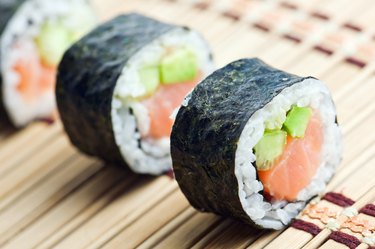
When handled and served properly, sushi -- typically a combination of raw fish and sticky, vinegared rice -- can be part of a healthful diet. If not prepared or handled properly, however, it can cause food poisoning or a parasitic infection, which can lead to stomach pain. It's also possible that you are experiencing an allergic reaction. Although the pain can be mild and may pass on its own, it's best to seek medical treatment when fish is involved in stomach pain.
Food Poisoning
Video of the Day
Food poisoning can occur when the fish, or another ingredient, used to make sushi is contaminated with bacteria. Improper handling and storage can contribute to food poisoning, as can eating fish that is full of toxins. Symptoms of food poisoning vary but can include abdominal pain, vomiting, diarrhea, fever, headache, nausea or -- in a serious case of food poisoning -- weakness. A mild case of food poisoning may only have mild abdominal cramps as a symptom and usually passes quickly. But MedlinePlus, a division of the National Institutes of Health, recommends seeking medical treatment for food poisoning as the result of eating fish.
Video of the Day
Parasitic Infection
Improperly prepared raw fish used in sushi can cause abdominal pain due to a parasitic infection, particularly Anisakis simplex -- which is a roundworm that is responsible for the majority of parasitic infections caused by consuming raw fish in the United States, according to Christina Frangou of "Gastroenterology & Endoscopy News." The Anisakis roundworm burrows into the wall of the stomach and causes symptoms that can include abdominal pain, nausea and vomiting. Symptoms can begin after a few minutes or within a few weeks after ingesting parasite-infested raw fish. Other types of parasitic infections cause similar symptoms.
Fish Allergy
Abdominal pain after eating sushi might be due to an allergic reaction. According to Food Allergy Research & Education, eight foods account for 90 percent of all reactions, and two of these foods are fish and shellfish -- common ingredients in sushi. An allergic reaction caused by food often has abdominal pain as its first, and possibly only, symptom. Other symptoms can include nausea, diarrhea and vomiting, as well as symptoms common to allergies such as sneezing, runny nose, hives and itching or tingling in the mouth. Consult a doctor to test for a specific allergy if you suspect you have one.
Taking Precautions
Eating sushi purchased from restaurants and stores that have rigorous health standards in place can help prevent the likelihood of food poisoning and decrease the risk of infection by parasites. Eating sushi made at home is more challenging, but using fish and other ingredients that have been properly stored and cleaned can help. Wash your hands thoroughly before handling any raw foods and ensure that all the utensils that you use have been properly sanitized with soap and water. If you are allergic to one type of fish, it's best to avoid all types of fish because more than half of the people in the United States who are allergic to one type of fish are allergic to others, according to Food Allergy Research & Education.
- The Sushi Book: Celeste Heiter
- University of Maryland Medical Center: Food Poisoning
- MedlinePlus: Food Poisoning
- Gastroenterology & Endoscopy News: An Informal Poll of Gastroenterologists on Sushi -- Do Those Who Treat Also Eat?
- HCP Live: Is It Safe to Eat Sushi? Bowel Obstruction Related to Anisakiasis
- Food Allergy Research & Education: Fish Allergy
- Food Allergy Research & Education: Food Allergy Symptoms
- Food Allergy Research & Education: Facts and Stats
- U.S. Food and Drug Administration: Fresh and Frozen Seafood -- Selecting and Serving It Safely
Is this an emergency? If you are experiencing serious medical symptoms, please see the National Library of Medicine’s list of signs you need emergency medical attention or call 911.